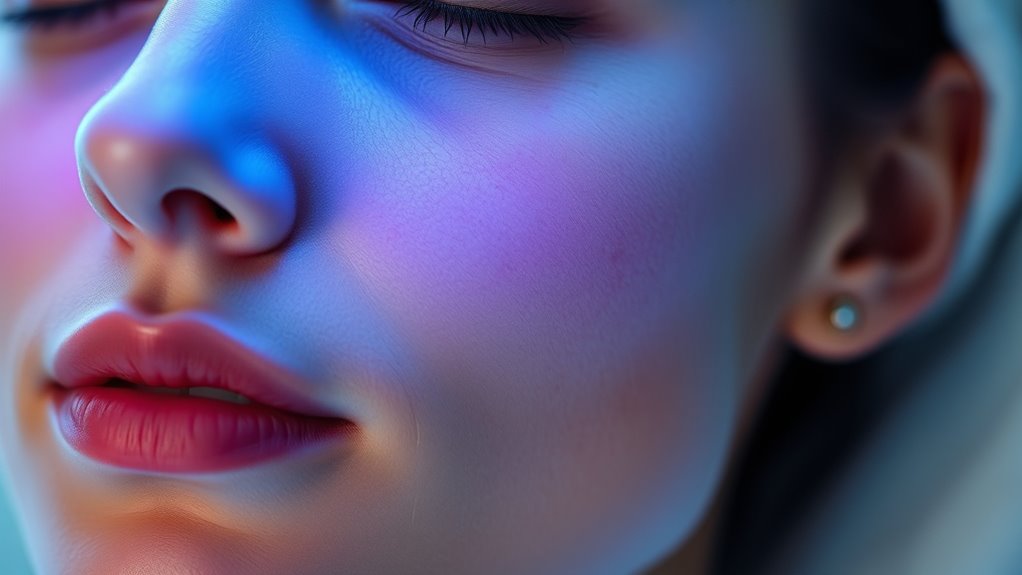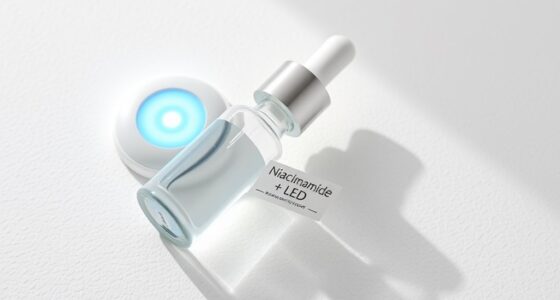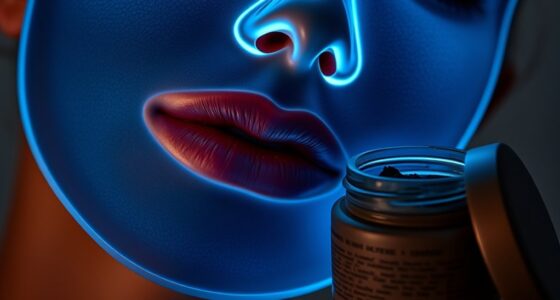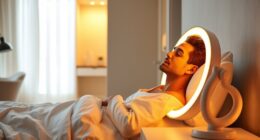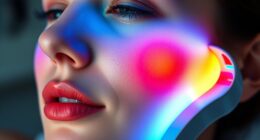To manage rosacea effectively with LED therapy, stay consistent with your treatments, ideally 2-3 times a week. Regular usage calms inflammation, reduces redness, and promotes healing over time. Skipping sessions can slow progress, so sticking to your routine is key. Combining LED therapy with gentle skincare and sun protection boosts results. If you keep up this routine, you’ll find your skin becomes calmer and healthier—discover more tips to optimize your plan.
Key Takeaways
- Consistent LED sessions, 2-3 times weekly, maximize reduction in redness and inflammation.
- Regular treatment promotes skin calmness and helps manage rosacea flare-ups effectively.
- At-home devices can support ongoing routines, but consistency is key for visible results.
- Combining LED therapy with gentle skincare enhances overall skin health and treatment outcomes.
- Patience and persistence are essential, as improvements develop gradually over several weeks.
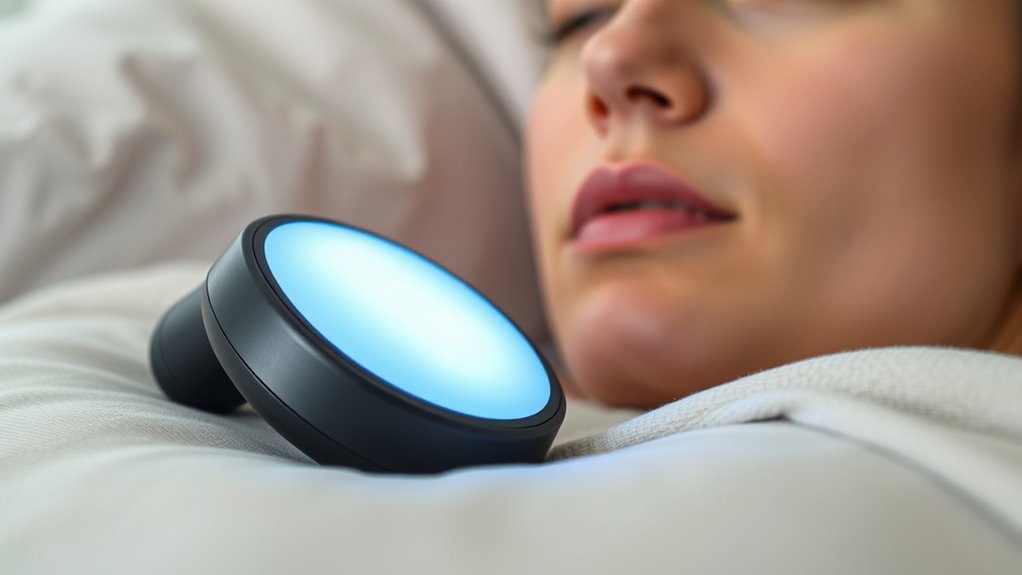
If you suffer from rosacea, you might find relief in LED therapy, a non-invasive treatment gaining popularity for its skin-calming benefits. Many people with rosacea struggle with redness, inflammation, and sensitivity, and traditional treatments don’t always provide consistent relief. LED therapy offers a gentle approach that targets these symptoms without harsh chemicals or invasive procedures. It works by using specific wavelengths of light to reduce inflammation, calm irritated skin, and promote healing. As you explore this option, it’s essential to understand that consistency is vital. Regular sessions, whether at a clinic or with an at-home device, can make a noticeable difference over time.
When you start LED therapy, you’ll notice that it’s painless and relaxing. During a session, you simply sit or lie comfortably while the device emits light onto your skin. The process usually lasts between 15 to 30 minutes, and you can expect to feel a warm sensation but no discomfort. Because it’s non-invasive, you don’t need downtime afterward, so you can incorporate treatments into your routine without interruption. Many users report that after a few sessions, their skin appears calmer, with reduced redness and fewer flare-ups. However, it’s important to remember that results vary from person to person, and some may need several weeks of consistent treatment before seeing significant improvements.
To maximize the benefits, you should follow a regular schedule, often recommended as two to three times a week initially. Skipping sessions or inconsistent application can slow down progress and diminish results. Patience is your best ally here; rosacea is a chronic condition, and managing it with LED therapy requires ongoing commitment. Alongside treatments, adopting a gentle skincare routine, avoiding known triggers, and protecting your skin from sun exposure will support your efforts. Many dermatologists suggest combining LED therapy with other management strategies for a more thorough approach.
You might also find that at-home LED devices are a convenient option, allowing you to maintain your treatment schedule easily. These devices vary in size and intensity, so it’s wise to choose one approved for rosacea or recommended by your dermatologist. No matter which route you take, the key is consistency. Over time, regular LED therapy can help keep your skin calmer, reducing the frequency and severity of flare-ups. Remember, patience and persistence are essential—sticking with your treatment plan can lead to visible, long-term improvements and give you better control over your rosacea.
Frequently Asked Questions
Can LED Therapy Replace Medication for Rosacea?
LED therapy can’t fully replace medication for rosacea, but it can complement your treatment plan. You might see improvements in redness and inflammation, yet medications often target underlying causes more effectively. Always consult your dermatologist before making changes. Combining LED with your prescribed treatments could boost results, but relying solely on LED isn’t recommended. Stay consistent with your dermatologist’s advice to manage rosacea effectively.
How Long Before I See Results From LED Treatments?
You might start noticing improvements in your rosacea within a few sessions, typically around 4 to 6 weeks of consistent LED therapy. However, individual results vary depending on severity and skin response. Keep in mind that ongoing treatments are essential for maintaining results. Stay patient and follow your dermatologist’s advice closely, as regular sessions and proper skincare will help you achieve the best possible outcome.
Are There Any Side Effects From Using LED for Rosacea?
Sure, LED treatments for rosacea are pretty gentle, so serious side effects are rare. You might experience mild redness, temporary dryness, or a slight tingling sensation—think of it as your skin’s way of saying, “Hey, I’m waking up.” No need to panic; these effects usually fade quickly. Just follow your dermatologist’s advice, and you’ll be safely on your way to calmer, happier skin without the drama.
Is LED Therapy Suitable for All Rosacea Types?
LED therapy can be suitable for most rosacea types, but it’s not a one-size-fits-all solution. You should consult your dermatologist to determine if this treatment matches your specific condition. While it often reduces redness and inflammation, some individuals with very sensitive skin or certain skin conditions might experience irritation. Always follow professional advice and monitor your skin’s response to guarantee safe and effective results.
How Often Should I Undergo LED Treatments for Best Results?
You should undergo LED treatments 2 to 3 times a week for the first month, then taper to once a week or biweekly for maintenance. This schedule can dramatically reduce redness and flare-ups, giving you a visible glow that feels almost too good to be true. Consistency is key—skipping sessions can slow your progress, so stick with it, and you’ll see a radiant, calm complexion that feels like a miracle.
Conclusion
Stay steady and serene by sticking with your LED routine. Consistency is key to calming redness and controlling rosacea’s relentless flare-ups. Keep calm, carry on, and don’t forget: patience and persistence are your best pals on this journey. With regular use, you’ll notice a noticeable difference, bringing brightness back to your skin and boosting your confidence. So, stay committed, stay calm, and let your LED routine lead you toward luminous, lovely skin.
